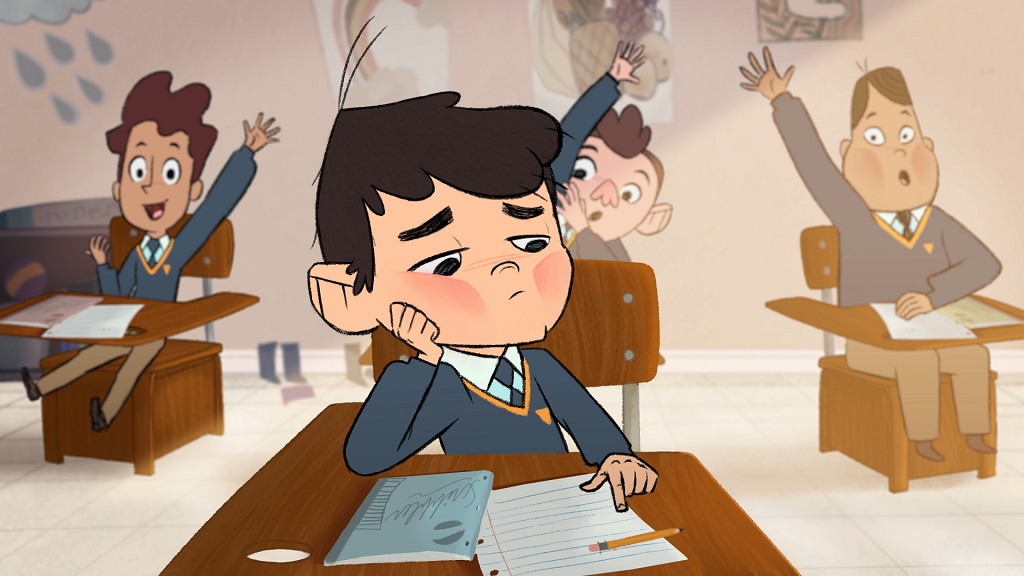An eccentric boy has trouble fitting in at school due to his obsession with crows. His affinity for crows, along with corvine behavior, makes him different from kids his age. What does he do in order to fit in, when in reality he was born to stand out?
Sean McCarron’s animated short film, “Corvine,” beautifully portrays this tale in a wordless approach. Instead, the film relies on the nuances of the animation, with excellent support from the brilliant score of Suad Bushnaq.
What this 10-minute hand-drawn animation results in is a quiet invitation to consider our own pursuits of passion and identity; and whether we support or impede the pursuits of those around us.
An Idyllic Life Through a Special Boy’s Eyes
“Corvine” begins with the boy waking up to the sound of birds outside their house, rushing to eat his breakfast, then going outside to play with his avian friends. Instead of fellow kids as playmates, he only spends his time playing with crows, who in turn eagerly wait for him every morning. Throughout the film, he displays corvine behavior from the moment he wakes up to the time he goes to bed. He doesn’t even speak, instead simply crowing to convey his emotions.
Nonetheless, his parents support him, as well as an elderly couple living next door whom the boy regularly visits. When visiting the latter, he would help them with menial tasks and he’d be fed cookies and milk, which the boy shares with his crow friends. Needless to say, the boy and his corvine friends live in peace and joy.
That is, until one morning when he finally has to go to school.

A Futile Exercise to Fit In, When One was Born to Stand Out
McCarron frames a pursuit of passion through a little boy’s point of view, which makes the rigid structure of an educational system perfect fodder for reining in one’s individuality in favor of what the norm is.
In this case, the boy receives bullying from his classmates for what they see as eccentric behavior. This comes to a head midway through the film, when a situation in the school prompts the involvement of the boy’s parents. We see the parents, once out of earshot, seemingly searching for answers on whether they’ve failed.
The film’s third act provides a surprising twist that I personally didn’t see coming. Credit to McCarron’s craft for storytelling, “Corvine” succeeds in keeping the audience invested without revealing too much how it ends.
Whatever the case, however, the film challenges its viewers whether fitting in is the right answer, when standing out is right up there among the correct choices.
Related Review: ‘January’ is a Thought-Provoking Meditation on One’s Pursuit of Passion and Love in the Time of War
‘Corvine’ and the Importance of Arts in Our (Everyday) Lives
Despite its relatively short runtime, “Corvine” manages to communicate one key thing. McCarron said that the film serves as “an expression of my love for traditional hand-drawn animation. It explores the important role of the Arts in our lives.”
In the film, the boy’s obsession with crows earned him the contempt of some of his classmates, and the befuddlement of others. In artistic pursuits, one can get the same reactions, if not worse.
Moreover, “Corvine” can also be a theme about obsession and the consequences it can have on a young person’s life. Indeed, the boy’s intense fascination with crows affects his daily activities, relationships, and overall well-being.
Finally, the use of crows is an interesting choice, since they often symbolize intelligence, mystery, and transformation in various cultures. By using crows, McCarron emphasizes its metaphor for the boy’s desire for knowledge, freedom, and personal growth.
Buoyed by visual storytelling in hand-drawn animated glory and a rich orchestral score that gorgeously underscores the boy’s emotional journey; “Corvine” is an uplifting short film about the importance of finding our passion — and never letting go.